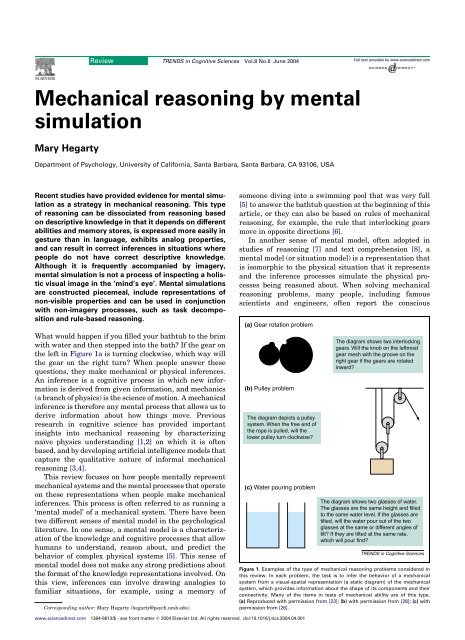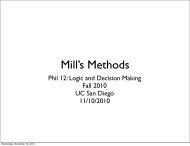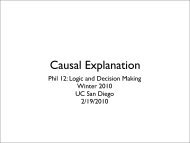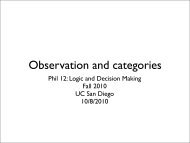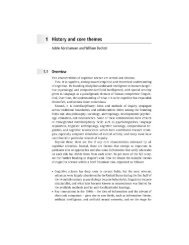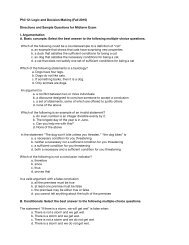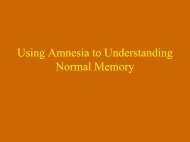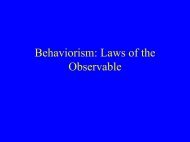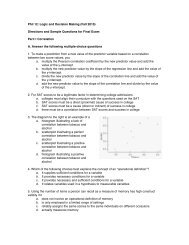Mechanical reasoning by mental simulation - Research - University ...
Mechanical reasoning by mental simulation - Research - University ...
Mechanical reasoning by mental simulation - Research - University ...
You also want an ePaper? Increase the reach of your titles
YUMPU automatically turns print PDFs into web optimized ePapers that Google loves.
<strong>Mechanical</strong> <strong>reasoning</strong> <strong>by</strong> <strong>mental</strong><br />
<strong>simulation</strong><br />
Mary Hegarty<br />
Review TRENDS in Cognitive Sciences Vol.8 No.6 June 2004<br />
Department of Psychology, <strong>University</strong> of California, Santa Barbara, Santa Barbara, CA 93106, USA<br />
Recent studies have provided evidence for <strong>mental</strong> <strong>simulation</strong><br />
as a strategy in mechanical <strong>reasoning</strong>. This type<br />
of <strong>reasoning</strong> can be dissociated from <strong>reasoning</strong> based<br />
on descriptive knowledge in that it depends on different<br />
abilities and memory stores, is expressed more easily in<br />
gesture than in language, exhibits analog properties,<br />
and can result in correct inferences in situations where<br />
people do not have correct descriptive knowledge.<br />
Although it is frequently accompanied <strong>by</strong> imagery,<br />
<strong>mental</strong> <strong>simulation</strong> is not a process of inspecting a holistic<br />
visual image in the ‘mind’s eye’. Mental <strong>simulation</strong>s<br />
are constructed piecemeal, include representations of<br />
non-visible properties and can be used in conjunction<br />
with non-imagery processes, such as task decomposition<br />
and rule-based <strong>reasoning</strong>.<br />
What would happen if you filled your bathtub to the brim<br />
with water and then stepped into the bath? If the gear on<br />
the left in Figure 1a is turning clockwise, which way will<br />
the gear on the right turn? When people answer these<br />
questions, they make mechanical or physical inferences.<br />
An inference is a cognitive process in which new information<br />
is derived from given information, and mechanics<br />
(a branch of physics) is the science of motion. A mechanical<br />
inference is therefore any <strong>mental</strong> process that allows us to<br />
derive information about how things move. Previous<br />
research in cognitive science has provided important<br />
insights into mechanical <strong>reasoning</strong> <strong>by</strong> characterizing<br />
naïve physics understanding [1,2] on which it is often<br />
based, and <strong>by</strong> developing artificial intelligence models that<br />
capture the qualitative nature of informal mechanical<br />
<strong>reasoning</strong> [3,4].<br />
This review focuses on how people <strong>mental</strong>ly represent<br />
mechanical systems and the <strong>mental</strong> processes that operate<br />
on these representations when people make mechanical<br />
inferences. This process is often referred to as running a<br />
‘<strong>mental</strong> model’ of a mechanical system. There have been<br />
two different senses of <strong>mental</strong> model in the psychological<br />
literature. In one sense, a <strong>mental</strong> model is a characterization<br />
of the knowledge and cognitive processes that allow<br />
humans to understand, reason about, and predict the<br />
behavior of complex physical systems [5]. This sense of<br />
<strong>mental</strong> model does not make any strong predictions about<br />
the format of the knowledge representations involved. On<br />
this view, inferences can involve drawing analogies to<br />
familiar situations, for example, using a memory of<br />
Corresponding author: Mary Hegarty (hegarty@psych.ucsb.edu).<br />
someone diving into a swimming pool that was very full<br />
[5] to answer the bathtub question at the beginning of this<br />
article, or they can also be based on rules of mechanical<br />
<strong>reasoning</strong>, for example, the rule that interlocking gears<br />
move in opposite directions [6].<br />
In another sense of <strong>mental</strong> model, often adopted in<br />
studies of <strong>reasoning</strong> [7] and text comprehension [8], a<br />
<strong>mental</strong> model (or situation model) is a representation that<br />
is isomorphic to the physical situation that it represents<br />
and the inference processes simulate the physical processes<br />
being reasoned about. When solving mechanical<br />
<strong>reasoning</strong> problems, many people, including famous<br />
scientists and engineers, often report the conscious<br />
(a) Gear rotation problem<br />
(b) Pulley problem<br />
The diagram depicts a pulley<br />
system. When the free end of<br />
the rope is pulled, will the<br />
lower pulley turn clockwise?<br />
(c) Water pouring problem<br />
www.sciencedirect.com 1364-6613/$ - see front matter q 2004 Elsevier Ltd. All rights reserved. doi:10.1016/j.tics.2004.04.001<br />
The diagram shows two interlocking<br />
gears. Will the knob on the leftmost<br />
gear mesh with the groove on the<br />
right gear if the gears are rotated<br />
inward?<br />
The diagram shows two glasses of water.<br />
The glasses are the same height and filled<br />
to the same water level. If the glasses are<br />
tilted, will the water pour out of the two<br />
glasses at the same or different angles of<br />
tilt? If they are tilted at the same rate,<br />
which will pour first?<br />
TRENDS in Cognitive Sciences<br />
Figure 1. Examples of the type of mechanical <strong>reasoning</strong> problems considered in<br />
this review. In each problem, the task is to infer the behavior of a mechanical<br />
system from a visual-spatial representation (a static diagram) of the mechanical<br />
system, which provides information about the shape of its components and their<br />
connectivity. Many of the items in tests of mechanical ability are of this type.<br />
(a) Reproduced with permission from [23]; (b) with permission from [28]; (c) with<br />
permission from [26].
Box 1. Spatial versus descriptive representations<br />
A representation is something that stands for something else. To<br />
understand the nature of a representation, we must specify the<br />
represented world (i.e. the referent), the representing world (i.e. the<br />
representational medium) and the mapping between these two worlds<br />
[53,54]. We must also specify what aspects of the represented world are<br />
represented, because all representations involve some abstraction and<br />
thus emphasize some aspects of the information over others.<br />
In mechanical <strong>reasoning</strong>, the represented world is essentially spatial<br />
because mechanics is the science of motion and motion is a spatial<br />
property. <strong>Mechanical</strong> <strong>reasoning</strong> depends on visible spatial information,<br />
such as the locations of objects, their shapes and connectivity. It also<br />
involves <strong>reasoning</strong> about non-visible properties, such as force, that are<br />
not visible, but are spatially distributed.<br />
In a spatial (depictive or diagrammatic) representation, the representing<br />
world is also a spatial array. Although spatial representations can<br />
represent both spatial and non-spatial information (e.g. graphs<br />
represent number), in the mechanical domain, they represent spatial<br />
properties. This means that the spatial relations between objects in the<br />
representation correspond to the spatial relations between the objects<br />
that they represent. For example, the spatial representation in Figure I<br />
might represent five gears in a gear chain (note that this representation<br />
is abstract in the sense that it does not represent much of the visible<br />
appearance of the gears).<br />
In a descriptive (‘sentential’ or ‘propositional’) representation the<br />
representing world is a set of facts or assertions about the represented<br />
world. These might be expressed in sentences, such as the following:<br />
There are 5 gears in a row.<br />
experience of <strong>mental</strong>ly simulating what will happen<br />
[7,9–11]. For example, Tesla reported that when he first<br />
designed a device, he would run it in his head for a few<br />
weeks to see which parts were most subject to wear [11].<br />
However, these accounts are anecdotal and based on<br />
subjective reports. Recent studies are providing more<br />
objective evidence that <strong>mental</strong> <strong>simulation</strong> is sometimes<br />
used in mechanical <strong>reasoning</strong>. This research suggests that<br />
<strong>mental</strong> <strong>simulation</strong> is based on internal spatial representations<br />
of mechanical systems (see Box 1), involves analog<br />
imagery, and can be dissociated from <strong>reasoning</strong> based on<br />
descriptive representations or explicit knowledge. At the<br />
same time, new research on <strong>mental</strong> imagery [12] and new<br />
theories of <strong>mental</strong> representation [13,14] are allowing us<br />
to specify more closely the nature of <strong>mental</strong> imagery and<br />
<strong>simulation</strong> processes. It is timely to review the literature<br />
on <strong>mental</strong> representations in mechanical <strong>reasoning</strong> in<br />
this light.<br />
Spatial representations in mechanical <strong>reasoning</strong><br />
Individual differences<br />
Analysis of individual differences provides one type of<br />
evidence that mechanical <strong>reasoning</strong> can depend on spatial<br />
representations. There is a strong dissociation between<br />
spatial and verbal ability. Spatial ability has been<br />
characterized as the ability to construct, maintain and<br />
transform spatial representations accurately [15]. Solving<br />
mechanical <strong>reasoning</strong> problems, such as the pulley<br />
problem shown in Figure 1b, is highly correlated with<br />
measures of spatial ability [16,17], but not significantly<br />
correlated with verbal ability. This provides preliminary<br />
evidence that mechanical inference involves transformations<br />
of spatial representations and depends less on<br />
verbal representations.<br />
www.sciencedirect.com<br />
Review TRENDS in Cognitive Sciences Vol.8 No.6 June 2004 281<br />
TRENDS in Cognitive Sciences<br />
Figure I. An example of a spatial representation (see text for details).<br />
Each gear meshes with the gear(s) on either side of it.<br />
The gear on the left is turning clockwise.<br />
In this case the mapping between the represented and representing<br />
worlds is arbitrary and based on conventions (e.g. the meaning of the<br />
words ‘gear’ and ‘five’).<br />
Inferences from spatial and descriptive representations involve<br />
different cognitive processes. Inferences from spatial representations<br />
result from spatial transformations, such as <strong>mental</strong> rotation and<br />
translation. For example, the person might infer the motion of the<br />
gears in a gear chain <strong>by</strong> <strong>mental</strong>ly rotating the successive gears. This<br />
corresponds to what we mean <strong>by</strong> <strong>mental</strong> <strong>simulation</strong>. By contrast,<br />
inferences from descriptive representations depend on inference rules,<br />
for example the rule ‘gears that mesh with each other turn in opposite<br />
directions’. This rule might also be used to infer the motion of the<br />
successive gears.<br />
Dual-task studies<br />
The dual-task methodology, often used in studies of<br />
working memory, provides another type of evidence for<br />
spatial representations in mechanical <strong>reasoning</strong>. Baddeley<br />
has proposed separate buffers in working memory,<br />
specialized for maintaining visuospatial representations<br />
and verbal representations, respectively [18]. In dual-task<br />
studies we measure the amount of interference between a<br />
primary task of interest (e.g. mechanical <strong>reasoning</strong>) and<br />
different secondary tasks assumed to depend on these<br />
working memory buffers. Sims and Hegarty [19] measured<br />
the interference between mechanical <strong>reasoning</strong> and maintenance<br />
of a visuospatial working memory load (assumed to<br />
involve the visuospatial buffer) versus a verbal working<br />
memory load (assumed to tap the verbal buffer). The<br />
visuospatial working memory load interfered more with<br />
mechanical <strong>reasoning</strong> than did the verbal working memory<br />
load. Similarly, mechanical <strong>reasoning</strong> interfered more with<br />
the visuospatial than the verbal memory load. These results<br />
suggest that mechanical <strong>reasoning</strong> depends on representations<br />
in the visuospatial buffer.<br />
Protocol studies<br />
A third type of evidence for spatial representation is<br />
provided <strong>by</strong> protocol studies in which people are asked to<br />
‘think aloud’ while solving mechanical inference problems.<br />
In these studies, individuals frequently use imitative<br />
gestures to communicate how the different components of<br />
a mechanical system move, and these gestures precede<br />
verbal descriptions of the component motions [6]. Gestures<br />
are particularly associated with communication of spatial<br />
information [20,21]. The fact that gestures precede verbal<br />
descriptions of the motions suggests that the internal<br />
representation is spatial rather than verbal.
282<br />
Analog processes in mechanical <strong>reasoning</strong><br />
Reaction times<br />
If mechanical <strong>reasoning</strong> problems are solved <strong>by</strong> <strong>mental</strong><br />
<strong>simulation</strong>, there should be evidence that the inference<br />
processes are analogous to the physical processes that<br />
they simulate. Evidence for analog imagery processes<br />
was first provided <strong>by</strong> Shepard and Metzler [22] who<br />
showed that <strong>mental</strong> rotation of objects is analogous to<br />
real physical rotation, in the sense that the time to rotate<br />
an object <strong>mental</strong>ly is proportional to the angle of<br />
rotation. Providing evidence for analog processes in<br />
mechanical inference, Schwartz and Black [23] found<br />
that when people inferred the rate of rotation of two<br />
interlocking gears (whether a knob on one gear would<br />
mesh with a groove on the second gear; Figure 1a), their<br />
response time was also proportional to the angle of<br />
rotation. When people were trained to use an analog<br />
imagery strategy to perform the gear task, reaction-time<br />
functions mimicked those of participants in no-training<br />
conditions, suggesting that imagery is the default<br />
strategy for performing this task. When questioned<br />
after the experiments, participants reported no knowledge<br />
of what the response-time function should be,<br />
indicating that they were not merely responding in<br />
accordance with expectations about the results of the<br />
experiment. It should be noted however, that there were<br />
also conditions under which people did not use analog<br />
imagery in this task: when they were taught an analytic<br />
strategy for performing the same task, and when they<br />
were shown a schematic diagram of the gears rather<br />
than a more realistic picture (see also [24]).<br />
Evidence for a dissociation of analog processes from<br />
explicit knowledge<br />
To demonstrate that people are <strong>reasoning</strong> <strong>by</strong> <strong>mental</strong><br />
<strong>simulation</strong>, it is important to show that they do not have<br />
explicit knowledge of the physical situation about which<br />
they are <strong>reasoning</strong>. Another task studied <strong>by</strong> Schwartz<br />
provides such evidence [25,26]. In this task, people had to<br />
judge the angle at which water would pour out of two<br />
glasses, a fat glass and a thin glass (Figure 1c). People<br />
performed very poorly when they answered from explicit<br />
knowledge. However if people answered <strong>by</strong> closing their<br />
eyes and rotating an empty glass (or an imaginary glass) to<br />
indicate the answer, they were almost always correct.<br />
Moreover, there was no systematic relationship between<br />
their answers in the two experi<strong>mental</strong> conditions. A<br />
similar dissociation was observed in a study of the ability<br />
of 5-year-old children to infer the trajectories of falling<br />
objects [27].<br />
Mental <strong>simulation</strong> versus visual imagery<br />
Mental <strong>simulation</strong> is often accompanied <strong>by</strong> the conscious<br />
experience of having a <strong>mental</strong> image [9–11]. One possible<br />
account of <strong>mental</strong> <strong>simulation</strong> is that it is a process of<br />
inspecting a <strong>mental</strong> image of the physical situation. In this<br />
account, a <strong>mental</strong> <strong>simulation</strong> is a holistic, dynamic, visual<br />
image of a physical situation. Several results in the<br />
research on mechanical inference suggest, however, that<br />
this is not an adequate account of <strong>mental</strong> <strong>simulation</strong>.<br />
www.sciencedirect.com<br />
Review TRENDS in Cognitive Sciences Vol.8 No.6 June 2004<br />
Piecemeal <strong>mental</strong> <strong>simulation</strong><br />
First, people <strong>mental</strong>ly simulate the behavior of complex<br />
mechanical systems piecemeal rather than holistically.<br />
Take, for example, the pulley system in Figure 1b. When<br />
you pull on the rope of this pulley system, all of its parts<br />
move at once. If the <strong>mental</strong> <strong>simulation</strong> process involves<br />
inspecting a holistic <strong>mental</strong> image of the system in motion,<br />
all parts of the system should move at once in the <strong>mental</strong><br />
image. When asked to predict how a part of the system<br />
moves, a person could merely generate the image and<br />
inspect the component in question to see how it moves. In<br />
this account, time to infer the movement of a component<br />
should be approximately the same for all mechanical<br />
components.<br />
Contrary to this, however, Hegarty found that people<br />
take more time to infer the motion of the lower pulley in<br />
Figure 1b, than the middle pulley and more time to infer<br />
the movement of the middle pulley than the upper pulley<br />
[28]. It was reasoned that people infer the motion of the<br />
components piecemeal, beginning <strong>by</strong> imagining the rope<br />
being pulled, and working through the causal chain of<br />
events in the motion of the system. Consistent with this<br />
account, when asked to infer the motion of a particular<br />
component (say the middle pulley), eye fixations indicated<br />
that people looked at that component, and components<br />
earlier in the causal chain of events (i.e. the upper rope and<br />
pulley) but not components later in that chain of events.<br />
This account is consistent with artificial intelligence<br />
models in proposing that mechanical <strong>reasoning</strong> involves<br />
sequentially propagating the effects of local interactions<br />
between components [3,29,30]. However, it differs from<br />
these accounts in proposing that the inference process at<br />
each ‘link’ in the causal chain might involve analog<br />
imagery.<br />
Non-visual representations in <strong>mental</strong> <strong>simulation</strong><br />
Second, <strong>mental</strong> <strong>simulation</strong> is not based purely on visual<br />
information, but also incorporates information about nonvisible<br />
entities and properties, such as force and density.<br />
For example, Schwartz [25] compared performance of the<br />
water-pouring problem depicted in Figure 1b when people<br />
were sitting holding an empty glass upright with when<br />
they were lying down, holding the glass sideways (that is,<br />
in the same relation to their bodies but in a different<br />
relation to gravity). In both cases, they were to imagine<br />
that the glass was upright, that water reached a particular<br />
level in the glass, and they were to turn the glass until the<br />
imagined water would start to pour out. Subjects were able<br />
to make the correct inference when sitting upright, but not<br />
able to do so when lying down, indicating that they could<br />
not ignore the effects of gravity. In another experiment,<br />
participants were told to imagine that the glasses<br />
contained molasses rather than water. In this case they<br />
tilted the glasses further, reporting that they were taking<br />
into account the rate at which the liquid would respond to<br />
the tilt (i.e. its viscosity).<br />
Action and <strong>mental</strong> <strong>simulation</strong><br />
Third, mechanical inference is often accompanied <strong>by</strong><br />
actions that simulate the motion of objects [6] and such<br />
actions can facilitate inference [26], suggesting that
<strong>mental</strong> <strong>simulation</strong> might involve motor representations as<br />
well as visual representations [31–34]. In fact, the results<br />
of an action (real or simulated) are not always available to<br />
visual awareness. Schwartz and Black asked participants<br />
to close their eyes and tilt a glass until an imagined<br />
amount of water would begin to pour out [26]. After<br />
indicating their answer with their eyes closed, they were<br />
allowed to open them and adjust the tilt of the glass. If the<br />
<strong>mental</strong> <strong>simulation</strong> process was accompanied <strong>by</strong> an<br />
accurate visual image of how far the glass was tilted,<br />
then participants should not adjust their tilt. However,<br />
almost all of their participants did make an adjustment.<br />
Other strategies in mechanical inference<br />
Finally, although there is strong evidence for <strong>mental</strong><br />
<strong>simulation</strong> as a strategy in mechanical inference, it is just<br />
one of the possible strategies used. Many mechanical<br />
inferences are made on the basis of rules of mechanical<br />
<strong>reasoning</strong> that can be easily verbalized (for examples, see<br />
[2,35]) or analogies to familiar situations [5]. Therefore<br />
mechanical <strong>reasoning</strong> is best thought of as a hybrid<br />
<strong>reasoning</strong> process that uses all of these inference processes<br />
[36]. Furthermore, <strong>mental</strong> <strong>simulation</strong> is often used in<br />
conjunction with other strategies, such as task decomposition,<br />
as in Hegarty’s pulley experiments [28]. Finally,<br />
<strong>mental</strong> <strong>simulation</strong> can lead to the discovery and formulation<br />
of rules of mechanical <strong>reasoning</strong>. When Schwartz<br />
and Black [6] asked people to solve gear problems such as<br />
the one discussed in Box 1, they initially <strong>mental</strong>ly<br />
simulated the motion of the individual gears, but on the<br />
basis of those <strong>simulation</strong>s discovered the simple rule that<br />
any two interlocking gears move in opposite directions and<br />
switched to a rule-based strategy. Schwartz and Black<br />
proposed that people use <strong>mental</strong> <strong>simulation</strong> in novel<br />
situations in which they do not have an available rule or<br />
when their rules are inadequate (e.g. are too narrow for the<br />
situation at hand).<br />
Knowledge representation in <strong>mental</strong> <strong>simulation</strong> of<br />
mechanical systems<br />
Visual vs. spatial representations<br />
If <strong>mental</strong> <strong>simulation</strong>s are not holistic <strong>mental</strong> images, how<br />
might we characterize the working memory representations<br />
on which they are based? Recent studies have made<br />
a distinction between spatial and visual imagery [12,37]<br />
corresponding to neural activity in the dorsal and ventral<br />
visual systems, respectively [38]. Visual imagery represents<br />
the visual appearance of an object, such as its shape,<br />
color or brightness. Spatial imagery represents of the<br />
spatial relationships between parts of an object, the location<br />
of objects in space, or their movement, and is not<br />
limited to the visual modality (e.g. one could have an<br />
auditory or haptic spatial image). Use of spatial imagery<br />
that encodes only essential spatial relations and omits<br />
visual details is associated with more success in verbal<br />
<strong>reasoning</strong> [39] and problem solving in physics [40],<br />
mathematics [41], and chess [42]. It is also associated<br />
with high spatial visualization ability [40,41]. It is likely<br />
that <strong>mental</strong> <strong>simulation</strong>s in mechanical <strong>reasoning</strong> also<br />
depend on transformations of spatial images.<br />
www.sciencedirect.com<br />
Review TRENDS in Cognitive Sciences Vol.8 No.6 June 2004 283<br />
Implicit vs. explicit knowledge<br />
We have seen that <strong>mental</strong> <strong>simulation</strong>s cannot be explained<br />
in terms of explicit knowledge of the physical situation, but<br />
can they be explained in terms of implicit knowledge? It<br />
might be argued that if a person infers the correct direction<br />
of motion of a gear or pulley during <strong>mental</strong> <strong>simulation</strong>, the<br />
person has, at some level, tacit or implicit knowledge of the<br />
correct answer [43,44]. This might be generic knowledge of<br />
physical constraints; for example, that solid objects that<br />
come in contact exert forces on each other, or that liquids<br />
conform to the shape of their containers. Very young babies<br />
demonstrate implicit knowledge of such physical constraints<br />
[45]. It is plausible that people fall back on this<br />
very early (perhaps innate) knowledge of the physical<br />
world in situations in which they must make mechanical<br />
inferences but do not have relevant explicit knowledge<br />
to draw on. However, what is important to the <strong>mental</strong><br />
<strong>simulation</strong> account is that this tacit, implicit or ‘deep’<br />
knowledge [6,7,46] is accessed or ‘reveals itself’ only<br />
during <strong>mental</strong> <strong>simulation</strong>.<br />
Representational format<br />
A more controversial question concerns the format of the<br />
knowledge representations underlying <strong>mental</strong> <strong>simulation</strong><br />
[37,43]. Clearly, at some level, all representations are<br />
encoded as neural signals, and yet the conscious experience<br />
of <strong>mental</strong> <strong>simulation</strong> is very different from that of<br />
applying inference rules [7,23]. At a minimum, the<br />
representations underlying <strong>mental</strong> <strong>simulation</strong> must be<br />
more similar to the experience of perceiving a mechanical<br />
system than are descriptive representations (Box 1). One<br />
possibility is that they are perceptual, that is, they involve<br />
some of the same neural activity involved in perceiving<br />
spatial properties [13,14,46]. For example, mechanical<br />
inference might involve partial activation of high-level<br />
spatial representations. By contrast, the representations<br />
involved in rule-based <strong>reasoning</strong> might be more abstract.<br />
Dissociations between abstract and more perceptual<br />
representations have also been found in studies of so called<br />
‘naïve physics’ [1,2]. For example, in situations where<br />
people cannot accurately predict motion trajectories<br />
(e.g. of a ball ejected from a curved tube), they can<br />
sometimes detect whether an animation shows the correct<br />
trajectory, although there are also limitations on this<br />
detection [47–49]. Perceptual representations might also<br />
be involved in ‘representational momentum’ – the perceptual<br />
phenomenon that when people view a moving<br />
object, they tend to remember its final position as displaced<br />
forward in space [50,51]. These effects can also be dissociated<br />
from explicit knowledge of motion learned in<br />
physics classes [52].<br />
Conclusion<br />
In summary, recent studies have provided evidence for<br />
<strong>mental</strong> <strong>simulation</strong> as a strategy in mechanical <strong>reasoning</strong>.<br />
This type of <strong>reasoning</strong> can be dissociated from <strong>reasoning</strong><br />
based on descriptive knowledge in that it depends on<br />
different abilities and memory stores, is expressed more<br />
easily in gesture than in language, exhibits analog<br />
properties, and can result in correct inferences in<br />
situations where people do not have correct descriptive
284<br />
Review TRENDS in Cognitive Sciences Vol.8 No.6 June 2004<br />
Box 2. Questions for future research<br />
† Under what conditions do people use <strong>simulation</strong> rather than rulebased<br />
<strong>reasoning</strong> or analogy in mechanical <strong>reasoning</strong>? What factors,<br />
including knowledge [6] and the nature of the visual display [19,20]<br />
affect strategy choice?<br />
† What is the nature of the internal representations underlying<br />
<strong>mental</strong> <strong>simulation</strong>? Are they represented in the visual modality? How<br />
much visual detail do they include? Do they also include information<br />
from other modalities, that is, are they multimodal?<br />
† How can we best characterize individual differences in <strong>mental</strong><br />
<strong>simulation</strong> ability? Do they reflect differences in the capacity of<br />
spatial working memory, differences in executive processes, such as<br />
task decomposition, which compensate for limitations in this<br />
capacity, or differences in knowledge of the mechanical situations<br />
to be simulated.<br />
† How complex a mechanical system can be simulated <strong>by</strong> spatial<br />
imagery? Does working memory limit the <strong>mental</strong> <strong>simulation</strong> of<br />
complex systems? Are some types of motion more difficult to<br />
simulate than others (e.g. rotation vs. translation)?<br />
† How does <strong>mental</strong> <strong>simulation</strong> change with expertise in a domain?<br />
Does expertise allow the <strong>mental</strong> <strong>simulation</strong> of more complex<br />
mechanical systems? With expertise, is <strong>mental</strong> <strong>simulation</strong> replaced<br />
<strong>by</strong> other forms of <strong>reasoning</strong>?<br />
† What are other possible situations in which people use <strong>mental</strong><br />
<strong>simulation</strong> in thinking? To what extent can the research on <strong>mental</strong><br />
<strong>simulation</strong> in mechanical <strong>reasoning</strong> be generalized to these<br />
situations?<br />
knowledge. Although it is frequently accompanied <strong>by</strong><br />
imagery, <strong>mental</strong> <strong>simulation</strong> is not a process of inspecting a<br />
holistic visual image in the ‘mind’s eye’. Rather, <strong>mental</strong><br />
<strong>simulation</strong>s are constructed piecemeal, include representations<br />
of non-visible properties and can be used in<br />
conjunction with non-imagery processes, such as task<br />
decomposition and rule-based <strong>reasoning</strong>. There is much to<br />
discover about the nature of the <strong>mental</strong> representations<br />
underlying <strong>mental</strong> <strong>simulation</strong>s, when it is used in<br />
mechanical <strong>reasoning</strong>, and its limitations as an inference<br />
process (see Box 2). The research to date suggests that<br />
mechanical <strong>reasoning</strong> provides an interesting domain in<br />
which to study the functions of spatial representations,<br />
and how people flexibly use these and other types of <strong>mental</strong><br />
representations in thinking.<br />
References<br />
1 McCloskey, M. (1983) Naïve theories of motion. In Mental Models<br />
(Gentner, D. and Stevens, A., eds), pp. 229–324, Erlbaum<br />
2 diSessa, A. (1993) Towards an epistemology of physics. Cognition and<br />
Instruction 10, 105–255<br />
3 DeKleer, J. and Brown, J.S. (1984) A qualitative physics based on<br />
confluences. Artif. Intell. 24, 7–83<br />
4 Forbus, K.D. (1984) Qualitative process theory. Artif. Intell. 24,<br />
85–168<br />
5 Gentner, D. (2002) Psychology of <strong>mental</strong> models. In International<br />
Encyclopedia of the Social and Behavioral Sciences (Smelser, N.J. and<br />
Bates, P.B., eds), pp. 9683–9687, Elsevier<br />
6 Schwartz, D.L. and Black, J.B. (1996) Shuttling between depictive<br />
models and abstract rules: induction and fall-back. Cogn. Sci. 20,<br />
457–497<br />
7 Johnson-Laird, P.N. (1998) Imagery, visualization and thinking. In<br />
Perception and Cognition at Century’s End (Hochberg, J., ed.),<br />
pp. 441–467, Academic Press<br />
8 Zwaan, R.A. and Radvansky, G.A. (1998) Situation models in language<br />
comprehension and memory. Psychol. Bull. 123, 162–185<br />
9 Clement, J. (1994) Use of physical <strong>simulation</strong> and imagistic <strong>simulation</strong><br />
in expert problem solving. In Implicit and Explicit Knowledge (Tirosh,<br />
D., ed.), pp. 204–242, Erlbaum<br />
www.sciencedirect.com<br />
10 Ferguson, E.S. (1992) Engineering and the Mind’s Eye, MIT Press<br />
11 Shepard, R.N. (1978) Externalization of <strong>mental</strong> images and the act<br />
of creation. In Visual Learning, Thinking and Communication<br />
(Randawa, B.S. and Coffman, W.E., eds), Academic Press<br />
12 Kosslyn, S.M. and Thompson, W.L. (2003) When is early visual cortex<br />
activated during visual <strong>mental</strong> imagery. Psychol. Bull. 129, 723–746<br />
13 Barsalou, L. (1999) Perceptual symbol systems. Behav. Brain Sci. 22,<br />
577–660<br />
14 Barsalou, L.W. et al. (2003) Grounding conceptual knowledge in<br />
modality-specific systems. Trends Cogn. Sci. 7, 84–91<br />
15 Carroll, J. (1993) Human Cognitive Abilities: a Survey of Factor-<br />
Analytical Studies, Cambridge <strong>University</strong> Press<br />
16 Hegarty, M. and Sims, V.K. (1994) Individual differences in <strong>mental</strong><br />
animation during mechanical <strong>reasoning</strong>. Mem. Cogn. 22, 411–430<br />
17 Hegarty, M. and Steinhoff, K. (1997) Use of diagrams as external<br />
memory in a mechanical <strong>reasoning</strong> task. Learning Individual<br />
Differences 9, 19–42<br />
18 Baddeley, A.D. (2002) Is working memory still working? European<br />
Psychol. 7, 85–97<br />
19 Sims, V.K. and Hegarty, M. (1997) Mental animation in the visualspatial<br />
sketchpad: evidence from dual-task studies. Mem. Cogn. 25,<br />
321–332<br />
20 Alibali, M.W. et al. (2001) Effects of visibility between speaker and<br />
listener on gesture production: Some gestures are meant to be seen.<br />
J. Mem. Lang. 44, 169–188<br />
21 Kita, S. and Oezyurek, A. (2003) What does cross-linguistic variation<br />
in semantic coordination of speech and gesture reveal? Evidence for an<br />
interface representation of spatial thinking and speaking. J. Mem.<br />
Lang. 48, 16–32<br />
22 Shepard, R.N. and Metzler, J. (1971) Mental rotation of threedimensional<br />
objects. Science 171, 701–703<br />
23 Schwartz, D.L. and Black, J.B. (1996) Analog imagery in <strong>mental</strong> model<br />
<strong>reasoning</strong>: depictive models. Cogn. Psychol. 30, 154–219<br />
24 Schwartz, D.L. (1995) Reasoning about the referent of a picture versus<br />
<strong>reasoning</strong> about the picture as the referent: An effect of visual realism.<br />
Mem. Cogn. 23, 709–722<br />
25 Schwartz, D.L. (1999) Physical imagery: kinematic vs. dynamic<br />
models. Cogn. Psychol. 38, 433–464<br />
26 Schwartz, D.L. and Black, T. (1999) Inferences through imagined<br />
actions: knowing <strong>by</strong> simulated doing. J. Exp. Psychol. Learn. Mem.<br />
Cogn. 25, 116–136<br />
27 Krist, H. et al. (1993) Intuitive physics in action and judgment: the<br />
development of knowledge about projectile motion. J. Exp. Psychol.<br />
Learn. Mem. Cogn. 19, 952–966<br />
28 Hegarty, M. (1992) Mental animation: inferring motion from static<br />
diagrams of mechanical systems. J. Exp. Psychol. Learn. Mem. Cogn.<br />
18, 1084–1102<br />
29 Forbus, K.D. et al. (1991) Qualitative spatial <strong>reasoning</strong>: the CLOCK<br />
project. Artif. Intell. 51, 417–471<br />
30 Joskowicz, L. and Sacks, E.P. (1991) Computational kinematics. Artif.<br />
Intell. 51, 381–416<br />
31 Schwartz, D.L. and Holton, D.L. (2000) Tool use and the effect of action<br />
on the imagination. Journal of Experi<strong>mental</strong> Psychology: Learning.<br />
Mem. Cogn. 26, 1655–1665<br />
32 Wexler, M. et al. (1998) Motor processes in <strong>mental</strong> rotation. Cognition<br />
68, 77–94<br />
33 Wohlschlager, A. and Wohlschlager, A. (1988) Mental and manual<br />
rotation. J. Exp. Psychol. Hum. Percept. Perform. 24, 397–412<br />
34 Kosslyn, S.M. et al. (2001) Imagining rotation <strong>by</strong> endogenous versus<br />
exogenous forces: distinct neural mechanisms. Neuroreport 12,<br />
2519–2525<br />
35 Hegarty, M. et al. (1988) Mental models of mechanical systems:<br />
individual differences in qualitative and quantitative <strong>reasoning</strong>. Cogn.<br />
Psychol. 20, 191–236<br />
36 Narayanan, N.H. et al. (1995) Behavior hypothesis from schematic<br />
diagrams. In Diagrammatic Reasoning: Cognitive and Computational<br />
Perspectives (Glasgow, J. et al., eds), pp. 501–534, MIT Press<br />
37 Kosslyn, S.M. (1994) Image and Brain: The Resolution of the Imagery<br />
Debate, MIT Press<br />
38 Ungerleider, L.G. and Mishkin, M. (1982) Two cortical visual systems.<br />
In Analysis of Visual Behavior (Ingle, D.J. et al., eds), pp. 549–586,<br />
MIT Press
Review TRENDS in Cognitive Sciences Vol.8 No.6 June 2004 285<br />
39 Knauff, M. and Johnson-Laird, P.N. (2002) Visual imagery can impede<br />
<strong>reasoning</strong>. Mem. Cogn. 30, 363–371<br />
40 Kozhevnikov, M. et al. (2002) Revising the visualizer/verbalizer<br />
dimension: evidence for two types of visualizers. Cogn. Instruction<br />
20, 47–77<br />
41 Hegarty, M. and Kozhevnikov, M. (1999) Types of visual-spatial<br />
representations and mathematical problem solving. J. Educ. Psychol.<br />
91, 684–689<br />
42 Chabris, C.F. and Hearst, E.S. (2003) Visualization, pattern recognition<br />
and forward search: effects of playing speed and sight of the<br />
position on grandmaster chess errors. Cogn. Sci. 27, 637–648<br />
43 Pylyshyn, Z. (2002) Mental imagery: in search of a theory. Behav.<br />
Brain Sci. 25, 157–238<br />
44 Pylyshyn, Z. (2003) Return of the <strong>mental</strong> image: are there really<br />
pictures in the brain? Trends Cogn. Sci. 7, 113– 118<br />
45 Baillargeon, R. (1994) How do infants learn about the physical world?<br />
Curr. Dir. Psychol. Sci. 3, 133–140<br />
46 Parsons, L.M. (1994) Temporal and kinematic properties of motor<br />
behavior reflected in <strong>mental</strong>ly simulated action. J. Exp. Psychol. Hum.<br />
Percept. Perform. 20, 709–730<br />
Endeavour<br />
the quarterly magazine for the history<br />
and philosophy of science<br />
You can access Endeavour online<br />
either through your BioMedNet<br />
Reviews subscription or via<br />
ScienceDirect, where you’ll find a<br />
collection of beautifully illustrated<br />
articles on the history of science, book<br />
reviews and editorial comment.<br />
Featuring<br />
47 Kaiser, M. et al. (1985) Judgments of natural and anomalous<br />
trajectories in the presence and absence of motion. Journal of<br />
Experi<strong>mental</strong> Psychology: Learning. Mem. Cogn. 11, 795–803<br />
48 Kaiser, M. et al. (1992) Influence of animation on dynamical<br />
judgments. J. Exp. Psychol. Hum. Percept. Perform. 18, 669–689<br />
49 Gilden, D.L. (1991) On the origins of dynamical awareness. Psychol.<br />
Rev. 98, 554–568<br />
50 Freyd, J. and Finke, R.A. (1984) Representational momentum. J. Exp.<br />
Psychol. Learn. Mem. Cogn. 10, 126–132<br />
51 Hubbard, T.L. (1995) Environ<strong>mental</strong> invariants in the representation<br />
of motion: Implied dynamics and representational momentum,<br />
gravity, friction, and centripetal force. Psychon. Bull. Rev. 2, 322–338<br />
52 Kozhevnikov, M. and Hegarty, M.A. (2001) Impetus beliefs as default<br />
heuristics: dissociation between explicit and implicit knowledge about<br />
motion. Psychon. Bull. Rev. 8, 439–453<br />
53 Markman, A.B. (1999) Knowledge Representation, Erlbaum<br />
54 Palmer, S.E. (1978) Funda<strong>mental</strong> aspects of cognitive representation.<br />
In Cognition and Categorization (Rosch, E.E. and Lloyd, B.B., eds),<br />
pp. 259–303, Erlbaum<br />
Resisting Insects: The Evolution of Scientific Approaches to the Chemical Control of Insect Pests, 1914–1960 <strong>by</strong> J. Ceccatti<br />
The City as a Context of Scientific Activity: Creating the Mediziner-Viertel in the fin-de-siècle Vienna <strong>by</strong> M. Rentetzi<br />
Sharing the Winnings: the 1946 Nobel Prize for Chemistry <strong>by</strong> K. Manchester<br />
‘I Got Rhythm’: Gershwin and Birth Control in the 1930s <strong>by</strong> P. Viterbo<br />
Astronomers against Newton <strong>by</strong> R. Higgitt<br />
Looking at J.B.S. Haldane <strong>by</strong> P. Fara<br />
Mary Boole and Curve Stitching <strong>by</strong> S. Innes<br />
and coming soon<br />
Sverre Petterssen and the Contentious (and Momentous) Weather Forecasts for D-Day, 6 June 1944 <strong>by</strong> J.R. Fleming<br />
Food of Paradise: Tahitian breadfruit and the Autocritique of European Consumption <strong>by</strong> P. White and E.C. Spary<br />
Two Approaches to Etiology: The Debate Over Smoking and Lung Cancer in the 1950s <strong>by</strong> M. Parascandola<br />
Learning from Education to Communicate Science as a Good Story <strong>by</strong> A. Negrete and C. Lartigue<br />
The Traffic and Display of Body Parts in the Early-19th Century <strong>by</strong> S. Alberti and S. Chaplin<br />
The Rise, Fall and Resurrection of Group Selection <strong>by</strong> M. Borrello<br />
The Prehistory of the Periodic Table <strong>by</strong> D. Rouvray<br />
The Future of Electricity in 1892 <strong>by</strong> G.J.N. Gooday<br />
The First Personal Computer <strong>by</strong> J. November<br />
Sherlock Holmes the Scientist <strong>by</strong> L. Snyder<br />
and much, much more . . .<br />
Locate Endeavour in the BioMedNet Reviews collection (http://reviews.bmn.com)<br />
or on ScienceDirect (http://www.sciencedirect.com)<br />
www.sciencedirect.com


